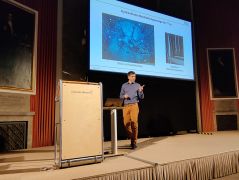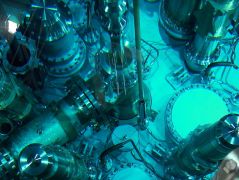MLZ is a cooperation between:
 > Technische Universität München
> Technische Universität München > Helmholtz-Zentrum Hereon
> Helmholtz-Zentrum Hereon
 > Forschungszentrum Jülich
> Forschungszentrum Jülich
MLZ is a member of:
 > LENS
> LENS > ERF-AISBL
> ERF-AISBL
MLZ on social media:

MLZ (eng)
Lichtenbergstr.1
85748 Garching
31.03.2022
Less waste from lower enriched Uranium targets
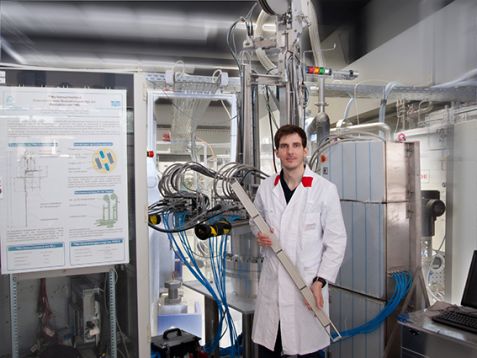
Dr. Tobias Chemnitz at the test facility for Mo-99 production at FRM II at the Garching reserach campus of the Technical University of Munich. © Reiner Müller, FRM II / TUM
Nuclear medicine utilizes technetium-99m among other things for tumor diagnostics. With over 30 million applications worldwide each year, it is the most widely used radioisotope. The precursor material, molybdenum-99, is mainly produced in research reactors. A study at the Heinz Maier-Leibnitz Research Neutron Source (FRM II) at the Technical University of Munich (TUM) now illustrates options to significantly reduce the radioactive waste produced during processing to a medical product.
Over 85 percent of all nuclear medicine diagnostic examinations use technetium-99m (Tc-99m). In Germany alone, more than 3 million doses are deployed every year. Coupled to suitable organic molecules, technetium is distributed throughout the body via the blood and accumulates in tumors, for example. When it decays there, the released radiation reveals the precise location of the tumor.
Technetium-99m is produced by irradiating uranium plates, so-called targets, with a high neutron flux that is practically only available at research reactors. Starting from uranium-235 this produces molybdenum-99 (Mo-99), which decays to Tc-99m with a half-life of 66 hours. With a half-life of six hours the latter converts to Tc-99, emitting gamma radiation that can be measured.
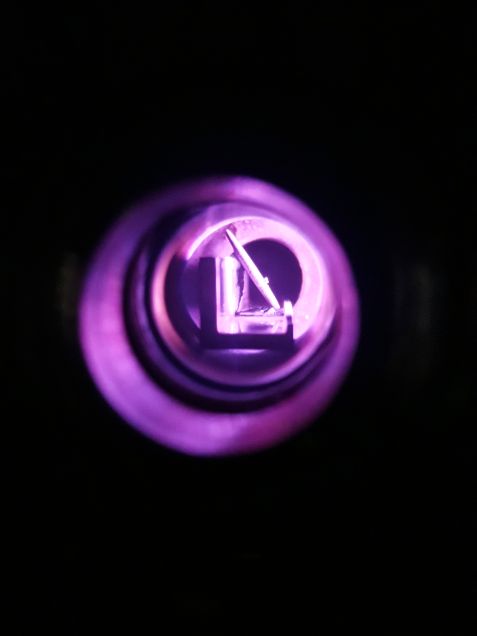
A uranium-molybdenum test target during fluorination with nitrogen trifluoride diluted with argon. At higher concentrations, the reaction is so violent that the target plate begins to glow. © Dr. Tobias Chemnitz
More waste from low-enriched uranium
The political desire to replace highly enriched uranium with low-enriched uranium also applies to targets being used in the medical field. This is why the Mo-99 irradiation facility currently under construction at FRM II is designed for targets with low-enriched uranium.
“However, this gives rise to a severe problem: the less the uranium plates are enriched with uranium-235, the lower the specific yield of Mo-99 during irradiation,” says Dr. Tobias Chemnitz, instrument scientist at the MEDAPP medical irradiation facility at FRM II.
To meet world-wide demand of Tc-99m, at least twice as many uranium plates must be irradiated and processed, depending on the technology used. This produces correspondingly higher volumes of waste. Chemnitz addressed this problem in his doctoral thesis at the Technical University of Munich.
New process avoids up to 15,000 liters of liquid radioactive waste
The final irradiated plates comprise only about 0.1 percent Mo-99. To ensure a purity sufficient for medical applications, the Mo-99 must be separated from the remaining material.
Currently, there are two standard processes in use, based on an acidic and an alkaline process, respectively. In the alkaline variant, the entire target is initially treated with caustic soda. In the process, Mo-99 is preferentially dissolved, while the uranium is insoluble in this solution and remains as a solid. The residual fission products are then separated from the aqueous solution in an elaborate chemical separation process.
Since highly enriched targets have been substituted by low-enriched targets, the same molybdenum yield doubles the volume of the resulting aqueous, medium-level radioactive waste to an annual volume of up to 15,000 liters worldwide – which still has to be cemented to be suitable for final disposal, so that in the end radioactive waste with a volume of 375,000 liters will be produced every year.
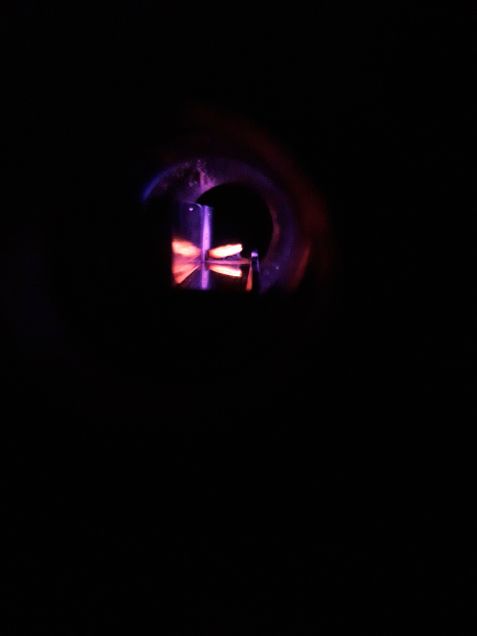
A uranium-molybdenum test target during fluorination with nitrogen trifluoride diluted with argon. At higher concentrations, the reaction is so violent that the target plate begins to glow, as can be seen in the picture. © Dr. Tobias Chemnitz
The solution: Get rid of the water
To alleviate this problem, Chemnitz and his colleague Riane Stene developed a new method for extracting Mo-99 without the use of aqueous chemistry.
In collaboration with the fluorine chemistry group at Philipps University of Marburg, the researchers developed a system in which the uranium-molybdenum test plates react with nitrogen trifluoride in a plasma. These plates had the same molybdenum content as would later be present in actual irradiated targets.
Finally, they separated the unwanted, excess uranium from the molybdenum via a light-controlled reaction. The separation of the two elements in this manner is every bit as efficient as the sodium hydroxide treatment performed in the first step of the conventional reprocessing procedure – with the notable exception that it produces no aqueous waste.
Only six major research reactors produce molybdenum-99
“Currently, six major irradiation facilities worldwide produce Mo-99. Of these research reactors, four are over 40 years old, which leads to unforeseen repairs and associated shutdowns – as has already happened in the recent past. That is why we are proud that the FRM II, together with the French Jules-Horowitz reactor, will be able to secure the European demand for Mo-99 in the future,” says Tobias Chemnitz.
TUM has submitted a patent application for the process. Regardless that further development work is still needed, Chemnitz is confident that this novel approach will provide a viable alternative to established processes in the medium term.
Original publications:
T. Chemnitz, Development of a dry-chemical extraction process for 99Mo and plasma-aided synthesis of transition metal hexafluorides. Dissertation, München, 2020.
R. E. Stene, Development of Dry and Non-Aqueous Techniques for the Separation of Molybdenum from Uranium and Investigations of Group Six Metal Fluoride and Oxyfluoride Chemistry. Dissertation, München, 2020.
R. E.Stene, T. Chemnitz, W. Petry, F. Kraus,
Reductive photo-chemical separation of the hexafluorides of uranium and molybdenum.
Journal of Fluorine Chemistry, 240, 109655 (2020)
More information:
Production of radioisotopes at the Research Neutron Source Heinz Maier-Leibnitz
Related News
MLZ is a cooperation between:
 > Technische Universität München
> Technische Universität München > Helmholtz-Zentrum Hereon
> Helmholtz-Zentrum Hereon
 > Forschungszentrum Jülich
> Forschungszentrum Jülich
MLZ is a member of:
 > LENS
> LENS > ERF-AISBL
> ERF-AISBL
MLZ on social media:



